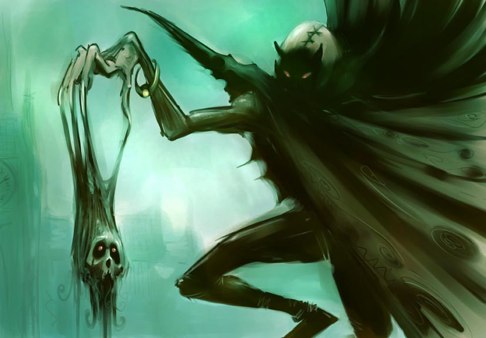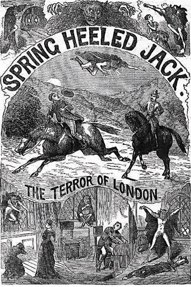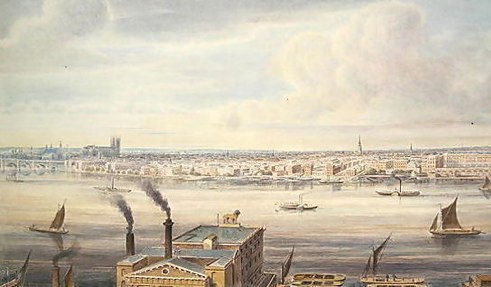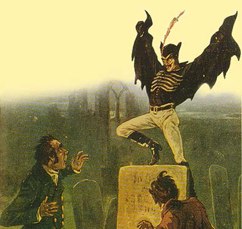 Maestro della Maddalena di Capodimonte, "Maddalena penitente" (17th century), oil on canvas (via Museo Regionale di Messina)
Maestro della Maddalena di Capodimonte, "Maddalena penitente" (17th century), oil on canvas (via Museo Regionale di Messina)
Attitudes toward corpses and death in 20th century Western society range from morbid fascination to forbidden subject. So it’s unusual when the news reports stories about people who are found living with a dead relative. Typically these tend to be people who are grieving and can’t let their loved one go, or who don’t want to report the death for fear of losing public assistance, or who simply have mental illness. It’s even more rare to find entire neighborhoods that live with the dead.
Communities of people who choose to live among the dead often do so for religious or economic reasons. The Aghori sadhus of India embrace death as part of their religion and rely on human remains for ritual and food. There are also large populations of people who dwell in cemeteries in Egypt and the Philippines for economic reasons. For these people there is nothing unusual about living among the dead since corpses and tombs are part of their communities.
The Aghori sadhus are a group of Hindu holy men who are devoted to Shiva, the god of destruction and transformation, and immerse themselves in death and filth as part of their faith. They are considered social outcasts because their beliefs and rituals contradict orthodox Hinduism.
Most Aghori live in Varanasi, a city in northern India on the banks of the Ganges, that is believed to be the favorite city of Lord Shiva. Varanasi is closely associated with funerary rituals due to the belief that death and cremation at Varanasi brings salvation in the afterlife. The city has several ghats, or stone embankments, along the Ganges where Hindus cremate the bodies of their dead loved ones.
 Funeral pyres on the Ganges (photograph by Dan Ruth)
Funeral pyres on the Ganges (photograph by Dan Ruth)
The Aghori cover their bodies with cremation ashes from the ghats or pull corpses from the Ganges to use in their rituals. They use dead bodies as altars, consume the flesh, and use the bones to make bowls and jewelry. Unlike holy men from other Hindu sects who are vegetarians and abstain from alcohol, the Aghoris will drink alcohol and cannibalize dead bodies. They believe that eating the flesh from a corpse will give them special powers. While embracing death for the Aghori is a religious choice, for others it’s an economic one.
 A tomb turned into a home in Cairo's City of the Dead (via Wikimedia)
A tomb turned into a home in Cairo's City of the Dead (via Wikimedia)
Cairo, with a population of about 20 million people, is one of the largest cities in the world; compared to New York and London that each have a population of about 8 million. Just southeast of Cairo there is a neighborhood known as al-Arafa — or City of the Dead — where an estimated 500,000 residents live in an ancient necropolis.
The City of the Dead was a founded in 642 AD as an Arabic cemetery during the Islamic conquest of Egypt. Some families have lived here for hundreds of years after they were displaced by rural and urban migration, a shortage of affordable housing, and natural disasters. They are considered outcasts by the middle and upper classes of Egyptian society.
 Cairo's City of the Dead (photograph by Dennis Jarvis)
Cairo's City of the Dead (photograph by Dennis Jarvis)
The City of the Dead consists of a grid of mausoleum structures that stretches for four miles. This community has limited electricity and running water, and leadership in the form of a neighborhood headman. Egyptian tombs in this neighborhood look like small houses, many of which have a garden. Families have set up kitchens, living areas, and bathrooms in these tombs. Traditionally the dead bodies of men and women are placed on shelves in separate underground rooms that are covered with stone slabs.
Since the revolution in 2013 there has been a rise in crime because the area is used for drug deals and to store weapons.

Families live among the graves of Manila's North Cemetery in the Philippines (photograph by Hywell Martinez)
The Cemeterio del Norte, or the Manila North Cemetery in the Philippines, dates to the 19th century and is the country’s largest public graveyard that spans over 130 acres. Hundreds of families have made the Manila North Cemetery home for decades because of urban population pressures and an affordable housing shortage in Manila, which has a population of 13 million.
Since the graves at the Manila North Cemetery are reused, its 6,000 residents live and work among human remains that lay out in the open. They have converted mausoleums into family homes, cafes and shops are run out of crypts, and children play among tombs. Many tomb dwellers care for the dead and provide services to mourners and visitors during All Saints Day.
Unlike the City of Dead in Cairo, this cemetery community lacks running water, electricity, and sanitation. Despite political pressure and a growing crime problem, residents prefer life among the graves to the unknown problems outside the cemetery walls.
To glimpse inside Manila's city among the dead, here's a short documentary from National Geographic, which includes one two-story home where the residents regularly exhume the dead, as well as plan to be buried in their own crypt house.
For more fascinating stories of forensic anthropology visit Dolly Stolze's Strange Remains, where a version of this article also appeared.

 Gwar lead singer Dave Brockie died Sunday, March 23, at 50, his manager said. His heavy metal group formed in 1984, billing itself as "Earth's only openly extraterrestrial rock band." Brockie, Gwar's frontman, performed in the persona of Oderus Urungus.
Gwar lead singer Dave Brockie died Sunday, March 23, at 50, his manager said. His heavy metal group formed in 1984, billing itself as "Earth's only openly extraterrestrial rock band." Brockie, Gwar's frontman, performed in the persona of Oderus Urungus.









 leaving behind only the shrill, hollow ghost of maniacal laughter and, of course, a panicked victim.
leaving behind only the shrill, hollow ghost of maniacal laughter and, of course, a panicked victim.
 footwear (the first patent for spring shoes wasn’t filed until 1889, but the materials required to build them existed for decades prior) as a means of further solidifying his demonic persona by increasing his jumping ability. Though the construction of a viable pair of such shoes, equipped for both running and jumping, would require certain metallurgic skills and resources, it seems that he did have metal claws constructed for his fingertips. At the same time, Jack’s agility could have just as easily been an inadvertent concoction of hysterical witnesses – an attempt to rationalize the sheer suddenness of the assaults – that was then co-opted and reiterated by policemen who now had an excuse for their inability to apprehend jumping Jack. And though it was two 1837 assaults involving clawing and leaping that earned Spring Heeled Jack his name, it was two 1838 attacks involving fire breathing that transformed the public’s general wariness into bona fide panic.
footwear (the first patent for spring shoes wasn’t filed until 1889, but the materials required to build them existed for decades prior) as a means of further solidifying his demonic persona by increasing his jumping ability. Though the construction of a viable pair of such shoes, equipped for both running and jumping, would require certain metallurgic skills and resources, it seems that he did have metal claws constructed for his fingertips. At the same time, Jack’s agility could have just as easily been an inadvertent concoction of hysterical witnesses – an attempt to rationalize the sheer suddenness of the assaults – that was then co-opted and reiterated by policemen who now had an excuse for their inability to apprehend jumping Jack. And though it was two 1837 assaults involving clawing and leaping that earned Spring Heeled Jack his name, it was two 1838 attacks involving fire breathing that transformed the public’s general wariness into bona fide panic. the art used randomly (and threateningly) on the streets of London, and (even if the person performing wasn’t dressed as a demon) would find it frightening. Take the analog of today’s guerilla magic fad – guerilla magic works precisely because, by removing the traditional physical environs of a performance, the intangible barrier between performer and audience is shattered, creating extremes of both surprise and veracity that don’t exist naturally within the confines of traditional spectatorship. Jack exploited this fact to add the last (and most convincing) attribute to his marauding devil – hellfire.
the art used randomly (and threateningly) on the streets of London, and (even if the person performing wasn’t dressed as a demon) would find it frightening. Take the analog of today’s guerilla magic fad – guerilla magic works precisely because, by removing the traditional physical environs of a performance, the intangible barrier between performer and audience is shattered, creating extremes of both surprise and veracity that don’t exist naturally within the confines of traditional spectatorship. Jack exploited this fact to add the last (and most convincing) attribute to his marauding devil – hellfire.